Occupational Environment Monitoring at Air Purifier Manufacturing Factory
99,000 ₫
Note: The above price is calculated for one sample, the price may vary depending on the area of the environment to be monitored and the fluctuations of the market. For more accurate price support, please refer to the quotation table or contact our consulting staff directly.
Environmental monitoring of the air purifier manufacturing factory is a session of collecting, analyzing, and evaluating workplace factors that may harm workers’ health.
Table of Contents
Toggle1. Overview of Air Purifier Manufacturing Factory
a. What is an air purifier manufacturing factory?
Manufacturing factory for air purifiers is a production facility specializing in manufacturing various types of air purifiers. An air purifier is a device used to filter and clean the air within a space, removing pollutants, dust, bacteria, viruses, and other small particles, thereby improving air quality and protecting human health.

b. Production stages in an air purifier manufacturing factory
Air purifier manufacturing factories typically carry out the following production stages:
- Design and development: The factory has a team of engineers and designers responsible for researching, developing, and designing air purifier products. They define technical requirements, select materials, design filtration systems, and develop technologies to ensure the performance and quality of the air purifiers.
- Production and assembly: Necessary components and accessories are either manufactured in-house or purchased from suppliers. These components are then assembled into a complete product in the factory. The production and assembly process may include mechanical and electronic processing, component assembly, quality inspection, and operational testing.
- Testing and quality control: After assembly, air purifiers are tested and quality-checked to ensure they operate efficiently and meet all standards and quality requirements. Tests may include airflow measurement, filtration efficiency testing, contaminant removal verification, and overall operational assessment.
- Packing and shipping: After quality inspection is completed, air purifiers are packed according to packaging standards to ensure safe protection during transport and delivery to customers.

c. Types of machinery used in air purifier manufacturing factories
In an air purifier manufacturing factory, several types of machinery are commonly used. Examples include:
- Filter pressing and cutting machines: These machines are used to press and cut filter panels from materials such as fiberglass, synthetic fibers, or composites. They ensure the filter panels have precise sizes and shapes.
- Welding and bonding machines: Used to weld and bond components of the air purifier. This can include electronic welding machines, ultrasonic welders, or laser welders to create strong and precise joints.
- Metal cutting and processing machines: Used to cut, bend, and process metal parts of the air purifier, including plasma cutters, laser cutters, metal bending machines, and lathes.
- Plastic molding and processing machines: Used to manufacture plastic components of the air purifier. Processes include injection molding, compression molding, machining, and finishing plastic parts.
- Assembly and testing machines: Used to assemble air purifier components and test their operation and performance. This can include automated assembly machines, airflow testing machines, contaminant removal testing machines, and overall functional testing machines.

d. Occupational diseases for workers in air purifier manufacturing factories
Workers in air purifier manufacturing factories may be exposed to various environmental and job-related hazards that can lead to occupational diseases. Common occupational diseases in this sector include:
- Respiratory diseases: Exposure to dust, chemicals, or other irritants during production can cause respiratory issues such as pneumonia, asthma, sinusitis, or bronchitis.
- Skin diseases: Contact with chemicals, soothing agents, or other irritants can cause dermatitis, skin irritation, eczema, or other skin conditions.
- Eye diseases: Machinery and production processes may emit ultraviolet rays or other irritants that can cause eye problems such as conjunctivitis, keratitis, or myopia.
- Hearing issues: Noise from machines and equipment can cause hearing damage or tinnitus.
- Musculoskeletal disorders: Jobs requiring long standing, heavy lifting, or awkward positions can cause back pain, joint stiffness, or spinal disorders.
To mitigate these risks and protect workers’ health, safety and occupational protective measures must be implemented, including using personal protective equipment (such as masks, gloves, and safety goggles), minimizing direct exposure to irritants, ensuring proper ventilation in the factory, and maintaining safe and ergonomic working conditions.

e. Popular types of air purifiers on the market
There are several popular types of air purifiers on the market, including:
- HEPA (High-Efficiency Particulate Air) purifiers: These use HEPA filters to remove fine particles, dust, pollen, pathogens, and other airborne pollutants.
- UV system purifiers: These use ultraviolet (UV) light to kill bacteria, viruses, and other pathogens in the air.
- Ionizer air purifiers: These generate negative ions that combine with small airborne particles to form larger particles, making them easier to filter.
- Chemical filtration purifiers: These use adsorbents such as activated carbon or chemical agents to remove chemical pollutants from the air.
- Antibacterial air purifiers: These use UV light, ozone, or antibacterial agents to eliminate bacteria, viruses, and pathogens in the air.
- Smart air purifiers: These automatically adjust based on air quality sensors, temperature, and humidity to maintain a clean and fresh indoor environment.
2. Overview of Workplace Environmental Monitoring Services
a. What is workplace environmental monitoring in air purifier manufacturing factories?
Workplace environmental monitoring (or occupational environment measurement) in air purifier manufacturing factories involves collecting, evaluating, and analyzing measurements of occupational environmental factors within the factory to implement timely interventions, minimize environmental impacts on workers’ health, and prevent occupational diseases. Workplace environmental monitoring is mandatory for air purifier manufacturing factories.
Environmental monitoring plays a critical role in protecting and enhancing workers’ health, as employees are the primary resource and direct source of profit for a business. Workers exposed to risk factors and occupational hazards above permissible limits may suffer health consequences and develop occupational diseases.
REGISTER WORKPLACE ENVIRONMENT MONITORING SERVICE
b. Nam Viet’s workplace environmental monitoring program
Nam Viet’s workplace environmental monitoring program is developed by monitoring engineers specializing in occupational safety and environmental protection. Aimed at ensuring workers’ health and safety, the program uses modern measurement methods to monitor air quality, water quality, and various microclimate, physical, and dust factors in the workplace. This program is crucial for maintaining a safe working environment and protecting workers’ health.
Furthermore, Nam Viet’s program also plays an important role in researching and developing solutions to improve workplace environmental quality. With the dedication and professionalism of the monitoring team, Nam Viet’s exclusive monitoring program is becoming a breakthrough in occupational safety management and environmental protection in Vietnam.

c. Standardization in workplace environmental measurement procedures
Standardization in Nam Viet’s workplace environmental measurement procedures is crucial to ensuring the accuracy and reliability of measurement results. The program follows recognized standards and standardized procedures of the Ho Chi Minh City Department of Health. This ensures collected data can be reliably used for workplace environment assessments and decision-making to improve occupational conditions and protect worker health.
These standardized procedures also ensure measurements are conducted by highly qualified monitoring specialists with years of experience, allowing managers and experts to trust the results from An Toan Nam Viet and make precise, valuable decisions for protecting workers’ health and the environment.
By applying standardization in workplace environmental measurements, Nam Viet demonstrates its commitment to providing a safe working environment and protecting worker health, while also contributing positively to the development and improvement of occupational safety and environmental management in Vietnam.
d. Reporting results of workplace environmental monitoring in air purifier factories
Workplace environmental monitoring results are prepared according to Form No. 04, Appendix III issued with Decree 44/2016/ND-CP and is produced in 2 copies: one sent to the contracted workplace and one retained by the monitoring organization.
The retention period of workplace environmental monitoring results follows legal regulations and is kept indefinitely.

e. Frequency of workplace environmental monitoring according to legal regulations
According to Clause 2, Article 18 of the Law on Occupational Safety and Hygiene 84/2015/QH13, employers must organize workplace environmental monitoring to assess harmful factors at least once per year.
f. Deadline for submitting workplace environmental monitoring reports according to legal regulations
The deadline for report submission is before December 31 each year. Enterprises of manufacturing establishments are required to submit workplace environmental monitoring reports to the local Department of Health where the production or business facility has its head office and where workers are employed.
When there are changes in technology, production processes, or when renovating/upgrading facilities that may generate new hazardous factors affecting workers’ health, manufacturing enterprises must update occupational hygiene records related to harmful factors requiring workplace environmental monitoring.
g. Regulations on penalties for violations regarding workplace environmental monitoring for employers
According to Article 27 of Decree No. 12/2022/ND-CP dated January 17, 2022, regulating administrative penalties in the field of labor, social insurance, and Vietnamese workers working abroad under contract:
- Clause 2: Fines from 2,000,000 to 5,000,000 VND for employers who fail to publicly inform employees at the workplace and inspection sites about monitoring results and hazard management immediately after receiving workplace environmental monitoring results and hazard management evaluations.
- Clause 3: Fines from 20,000,000 to 40,000,000 VND for employers who fail to conduct workplace environmental monitoring to control health risks for workers as required by law.
- Clause 4: Fines from 40,000,000 to 60,000,000 VND for employers who collude with environmental monitoring organizations to commit fraud in monitoring activities but not to the level of criminal prosecution.
3. Harmful Environmental Factors for Workers in Air Purifier Manufacturing Plants
When working in air purifier manufacturing plants, workers may encounter several harmful environmental factors. Below are some potential environmental factors that may harm workers:
- Dust and fine particles: The air purifier manufacturing process can generate dust and fine particles from materials, machining, or assembly processes. Prolonged exposure to dust and fine particles may cause respiratory irritation, pneumonia, and other health issues.
- Chemicals: Some chemicals may be used during air purifier production, including solvents, adhesives, and coating agents. Exposure to these substances can irritate the skin, eyes, and respiratory tract, and may pose dangers if not handled and controlled properly.
- Noise: Operation of machinery in air purifier manufacturing plants can produce high noise levels. Continuous and intense noise can cause stress, insomnia, and hearing damage.
- Temperature and humidity: The working environment in the factory may have high temperature and humidity due to production processes and equipment operation. Excessive heat or cold, combined with inappropriate humidity, can cause fatigue, discomfort, and health hazards for workers.
- Radiation: During air purifier production, devices that emit ultraviolet (UV) rays or other light sources may be used. Exposure to radiation can be harmful to the skin and eyes, and protective measures must be followed to ensure workers’ safety.
REGISTER FOR OCCUPATIONAL ENVIRONMENT MONITORING SERVICE
4. Measures to Improve the Working Environment in Air Purifier Manufacturing Plants
To improve the working environment in air purifier manufacturing plants and protect workers’ health, the following measures can be applied:
- Ensure ventilation and fans: Install ventilation systems and fans to provide fresh and cool air in the factory. This helps reduce humidity, remove moisture, and eliminate harmful substances in the air.
- Dust and fine particle management: Use effective dust extraction systems to minimize dust and fine particles during production. Ensure regular cleaning of work areas to prevent accumulation of dust and fine particles.
- Use of protective equipment: Provide personal protective equipment such as masks, safety goggles, gloves, and protective clothing to shield workers from irritants and harmful dust.
- Safety training and supervision: Train workers on safe work procedures and proper use of protective equipment. Conduct regular inspections and supervision to ensure compliance with occupational safety regulations.
- Noise control: Apply soundproofing measures, such as isolating noisy work areas, using noise-reducing equipment, and ensuring workers use hearing protection.
- Waste management: Handle production waste according to regulations and guidelines. Ensure proper classification, collection, transportation, and disposal of waste without causing environmental pollution or affecting workers’ health.
- Periodically organize occupational environment monitoring in factories, collect and analyze harmful factors for workers, and adjust to reduce hazards to prevent occupational diseases.
5. Benefits of Periodic Monitoring in Air Purifier Manufacturing Plants
An Toan Nam Viet provides enterprises with excellent benefits when using occupational environment monitoring services in compliance with Decree 44/2016/ND-CP on the management and control of harmful factors in the working environment affecting workers.
- Enterprises can actively control harmful factors in workshops or factories.
- Receive consulting and recommendations to minimize harmful factors and improve working environment quality.
- Indirectly protect human resources, a key factor in business development.
- Reduce the negative impact of occupational diseases on health, thereby minimizing future treatment costs.
- Improve workers’ health, which ensures product quality and maintains productivity.
- Comply with occupational safety laws, avoiding legal risks.
- Enhance credibility and professionalism, thereby elevating the enterprise’s brand.
Nam Viet’s environmental monitoring service is a solution to minimize occupational disease risks, contributing to a healthy and high-quality working environment.

6. National Occupational Environment Monitoring Center
Occupational Environment Monitoring Center of Nam Viet is a professional unit specializing in monitoring and measuring the quality of occupational environments nationwide across all provinces in Vietnam. With a team of experienced monitoring specialists, the center uses modern measuring equipment, ensuring accuracy and reliability.
In addition to providing monitoring services, the center assists clients with planning, handling, and tracking occupational environment issues. With the motto “customers are the center,” the center prioritizes client satisfaction, meets all client needs, and is committed to delivering the best solutions for businesses.
REGISTER FOR OCCUPATIONAL ENVIRONMENT MONITORING SERVICE
With investments in technology, equipment, and personnel, Nam Viet’s monitoring center has become one of the most reputable units in occupational environment monitoring in Ho Chi Minh City, with the following objectives:
- We highly value our brand reputation and service quality.
- We provide clients with the best and most suitable solutions.
- Alongside experienced Masters and Engineers, we aim to protect the environment and benefit enterprises.
- By partnering with Nam Viet’s Monitoring Team, companies receive professional service from experts and the best cost advantages.
The occupational environment monitoring process at Nam Viet includes the following steps:
- Before conducting monitoring, we ensure all equipment is calibrated and adjusted according to legal regulations.
- Carry out the monitoring process fully and correctly as committed to the Department of Health.
- Report monitoring results honestly to employers.
- If monitoring results indicate unsafe conditions for workers, Nam Viet will provide corrective solutions, and the workplace will implement the following:
- Implement measures to improve working conditions to minimize harmful factors and prevent occupational diseases.
- Organize health checkups to detect early occupational and work-related diseases for employees in unsafe environments.
- Provide workers with in-kind benefits according to labor law regulations.

7. Occupational Environment Monitoring Service Price Quotation
To help enterprises carry out occupational environment monitoring professionally and effectively, Nam Viet provides clients with a detailed price quotation for occupational environment monitoring services with quality and reasonable costs.
- Our quotation provides detailed information about the prices of monitoring services offered, including costs for transportation, measurement, analysis, and reporting. Clients can trust the accuracy and reliability of our monitoring reports.
- We are committed to offering competitive and reasonable prices and are always ready to provide fast and professional consultation regarding monitoring services.
- With Nam Viet’s quotation, clients can easily select service packages suitable for their needs. We are committed to delivering the highest satisfaction with professional service quality.
No comments yet

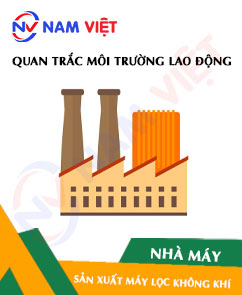
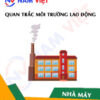
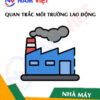
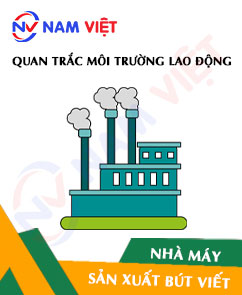


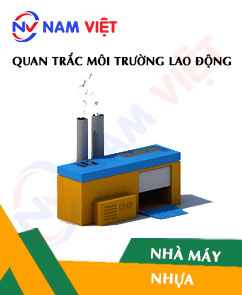

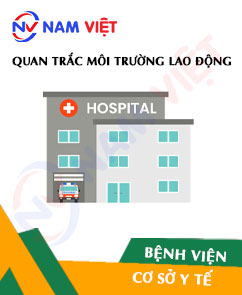


Review Occupational Environment Monitoring at Air Purifier Manufacturing Factory
There are no reviews yet.